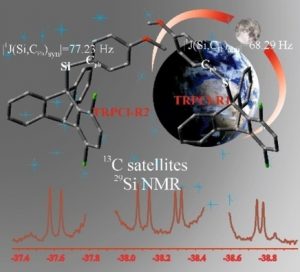Blue‐Shift Hydrogen Bonds in Silyltriptycene Derivatives: Antibonding σ* Orbitals of the Si−C Bond as Effective Acceptors of Electron Density

Dr. Adam Mames, Dariusz Gołowicz, Dr. Mariusz Pietrzak, Dr. Krzysztof Kazimierczuk, Prof. Sławomir Szymański, Dr. Tomasz Ratajczyk
Triptycene derivatives are widely utilized in different fields of chemistry and materials sciences. Their physicochemical properties, often of pivotal importance for the rational design of triptycene‐based functional materials, are influenced by noncovalent interactions between substituents mounted on the triptycene skeleton. Herein, a unique interaction between electron‐rich substituents in the peri position and the silyl group located on the bridgehead sp3‐carbon is discussed on the example of 1,4‐dichloro‐9‐(p‐methoxyphenyl)‐silyltriptycene (TRPCl) which exists in solution in the form of two rotamers differing by dispositions, syn or anti, of the Si−CPh (the CPh atom is from the p‐methoxyphenyl group) bond against the peri‐Cl atom. For the first time, substantial differences between the Si−CPh bonds in these two dispositions are identified, based on indirect experimental and direct theoretical evidence. For these two orientations, the experimental 1J(Si,CPh) values differ by as much as 10 percent. The differences are explained in terms of effective electron density transfer from the peri‐Cl atom to the antibonding σ* orbitals of the Si−X bonds (X=H, CPh) oriented anti to that atom. The electronic effects are revealed by an NBO analysis. Connections of these observations with the notion of blue‐shifting hydrogen bonds are discussed.

